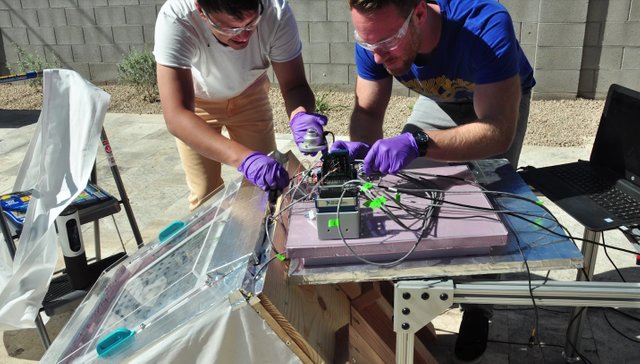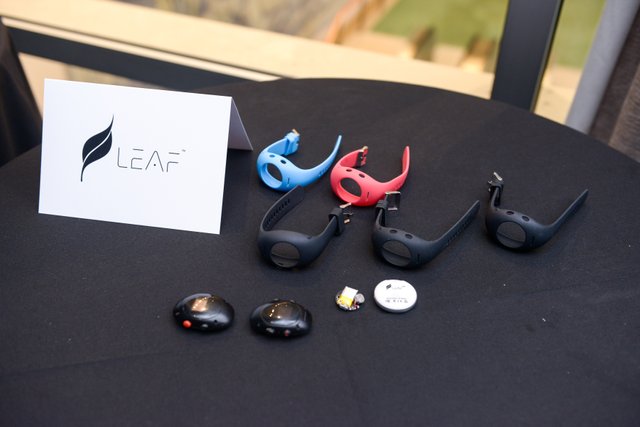Gadgets – TechCrunch
This box sucks pure water out of dry desert air
For many of us, clean, drinkable water comes right out of the tap. But for billions it’s not that simple, and all over the world researchers are looking into ways to fix that. Today brings work from Berkeley, where a team is working on a water-harvesting apparatus that requires no power and can produce water even in the dry air of the desert. Hey, if a cactus can do it, why can’t we?
While there are numerous methods for collecting water from the air, many require power or parts that need to be replaced; what professor Omar Yaghi has developed needs neither.
The secret isn’t some clever solar concentrator or low-friction fan — it’s all about the materials. Yaghi is a chemist, and has created what’s called a metal-organic framework, or MOF, that’s eager both to absorb and release water.
It’s essentially a powder made of tiny crystals in which water molecules get caught as the temperature decreases. Then, when the temperature increases again, the water is released into the air again.
 Yaghi demonstrated the process on a small scale last year, but now he and his team have published the results of a larger field test producing real-world amounts of water.
Yaghi demonstrated the process on a small scale last year, but now he and his team have published the results of a larger field test producing real-world amounts of water.
They put together a box about two feet per side with a layer of MOF on top that sits exposed to the air. Every night the temperature drops and the humidity rises, and water is trapped inside the MOF; in the morning, the sun’s heat drives the water from the powder, and it condenses on the box’s sides, kept cool by a sort of hat. The result of a night’s work: 3 ounces of water per pound of MOF used.
That’s not much more than a few sips, but improvements are already on the way. Currently the MOF uses zicronium, but an aluminum-based MOF, already being tested in the lab, will cost 99 percent less and produce twice as much water.
With the new powder and a handful of boxes, a person’s drinking needs are met without using any power or consumable material. Add a mechanism that harvests and stores the water and you’ve got yourself an off-grid potable water solution.
“There is nothing like this,” Yaghi explained in a Berkeley news release. “It operates at ambient temperature with ambient sunlight, and with no additional energy input you can collect water in the desert. The aluminum MOF is making this practical for water production, because it is cheap.”
He says there are already commercial products in development. More tests, with mechanical improvements and including the new MOF, are planned for the hottest months of the summer.
Women’s Safety XPRIZE $1M winner is a smart, simple panic button
Devices like smartphones ought to help people feel safer, but if you’re in real danger the last thing you want to do is pull out your phone, go to your recent contacts and type out a message asking a friend for help. The Women’s Safety XPRIZE just awarded its $1 million prize to one of dozens of companies attempting to make a safety wearable that’s simple and affordable.
The official challenge was to create a device costing less than $40 that can “autonomously and inconspicuously trigger an emergency alert while transmitting information to a network of community responders, all within 90 seconds.”
Anu and Naveen Jain, the entrepreneurs who funded the competition, emphasized the international and very present danger of sexual assault in particular.
“Women’s safety is not just a third world problem; we face it every day in our own country and on our college campuses,” said Naveen Jain in the press release announcing the winner. “It’s not a red state problem or a blue state problem but a national problem.”
“Safety is a fundamental human right and shouldn’t be considered a luxury for women. It is the foundation in achieving gender equality,” added Anu Jain.
Out of dozens of teams that entered, five finalists were chosen in April: Artemis, Leaf Wearables, Nimb & SafeTrek, Saffron and Soterra. All had some variation on a device that either detected or was manually activated during an attack or stressful situation, alerting friends to one’s location.
 The winner was Leaf, which had the advantage of having already shipped a product along these lines, the Safer pendant. Like any other Bluetooth accessory, it keeps in touch with your smartphone wirelessly and when you press the button twice your emergency contacts are alerted to your location and need for help. It also records audio, possibly providing evidence later or a deterrent to harassers who might fear being identified.
The winner was Leaf, which had the advantage of having already shipped a product along these lines, the Safer pendant. Like any other Bluetooth accessory, it keeps in touch with your smartphone wirelessly and when you press the button twice your emergency contacts are alerted to your location and need for help. It also records audio, possibly providing evidence later or a deterrent to harassers who might fear being identified.
It’s not that it’s an original idea — we’ve had various versions of this for some time, and even covered one of the other finalists last year. But they haven’t been quantitatively evaluated or given a platform like this.
“These devices were tested in many conditions by the judges to ensure that they will work in real-life cases where women face dangers today. They were tested in no-connectivity areas, on public transit, in basements of buildings, among other environments,” explained Anu Jain to TechCrunch. “Having the capability to record audio after sending the alert was one of the main differentiators for Leaf Wearables. Their chip design and software was also easy to be integrated into other accessories.”
Hopefully the million dollars and the visibility from winning the prize will help Leaf get its product out to people who need it. The runners-up don’t seem likely to give up on the problem, either. And it seems like the devices will only get better and cheaper — not that this will change the world on its own.
“Prices will come down as the sensor prices drop. In many countries it will require community support to be built,” continued Jain. “These technologies can act as a deterrent but in the long term culture of violence again women must change.”
Anker’s Spirit earbuds are wireless and waterproof
Anker, a battery maker turned accessory house, recently released the $39 Spirit X earbuds under their Soundcore brand. Aimed at runners and other heavy sweaters, the earbuds are completely waterproof under the IPX7 rating, a classification that means it can stand up to 1 meter of submersion.
What this means is that you get a surprisingly cheap and rugged set of workout earbuds that you’re not afraid to get a little dirty.
I tested a pair and found them quite nice for running. The rubber ear hooks kept them in place and the sound quality was not horrible, especially compared to my previous pair of Philips corded headphones. The sound quality, while a bit muffled, is what you’d expect from a standard pair of sports headphones, and the rubber earbuds stayed in place quite nicely. The company claims the headphones have a 12-hour battery life, which is about right — I used them for a few days and saw little change in the battery level.
A small flap on the bottom of the control bar hides a micro USB port for charging and there are three buttons — volume up, track advance and volume down. There are no voice prompts, but there is a built-in microphone for calls.
These are not swimming headphones. The IPX7 rating means they’ll stand up to sweat and rain but not a few dozen laps in the pool. An aqua-phobic nano-coating keeps the drops out of the inside of the headphones and should let you keep trucking long after other headphones have rusted out.
Long thought of as a bargain Amazon brand, Anker is expanding its reach and understanding of the market. By building inexpensive gear for those who don’t mind a slight trade-off in audio quality, they’ve hit an interesting spot in the headphone market. While this won’t beat your high-end over-ear headphones with all the trimmings, sometimes a $40 pair of daily wear earbuds is all you need.

Indiegogo expands its efforts to help Chinese startups reach global consumers
While crowdfunding company Indiegogo has been running a pilot program in China for the past couple of years, it’s now building on those efforts with the launch of the Indiegogo China Global Fast-Track Program.
CEO David Mandelbrot is in Shenzhen, China this week to announce the program, which is designed to help Chinese entrepreneurs reach a global audience. In an email, he told me:
The China Pilot Program is officially out of pilot phase — today, we are officially launching the Indiegogo Global Fast Track. During the pilot phase, the team experimented with different ways to help service Chinese brands and manufacturers who were looking to launch products overseas. After helping companies raise over $100 million and launch over 3,000 China-based projects over two years time, the team has finalized its new suite of services.
Those services include guidance around crowdfunding and marketing in the United States and other countries, access to a network of more than 65 service providers (including retailers and marketing firms, as well as Indiegogo’s manufacturing partner Arrow Electronics and shipping partner Ingram Micro) and Chinese-to-English consultation with bilingual staff.
Even while in the pilot phase, Indiegogo has had some success stories in helping Chinese companies launch globally. For example, Bluetooth headphone company crazybaby raised more than $4 million across three campaigns.
Mandelbrot said Indiegogo also has opened a satellite office in the Tencent incubator in Shenzhen — a manufacturing hub that’s become a hub for hardware startups, too.
Intel teases a massive 28-core, single-socket chip that will launch later this year
Intel is feeling increasing pressure from AMD and Qualcomm and the competition will get even more intense if reports that Apple is working on its own chips to replace Intel processors in Macs are true. In an interview with Engadget last week before Computex, Intel’s client computing head Gregory Bryant said that Intel would reveal an even more powerful chip than last year’s showstopper, the 18-core, 36-thread Intel i9-7980XE.
As it turns out, Intel’s Computex keynote today in Taipei, Taiwan focused more on previewing future launches, but Bryant did reveal that later this year, the company will unveil a single-socket processor with a whooping 28-cores that will run at 5 GHz. In comparison, AMD’s Threadripper processor, one of Intel’s closest competitors, has 16-cores and 32 threads.
Bryant said the new chip will debut in the fourth quarter of this year but did not reveal pricing details (for reference, the Intel i9-7980XE is currently priced at $1,999, so it’s reasonable to assume the new chip will cost at least that).
Intel also released a new limited edition chip, the Core i7-8086K, which runs at 5.0 Ghz (a new milestone for its chips), to mark the anniversary of the first x86 processor, and will give away 8,086 of them in a sweepstake.
Other teasers included Intel’s plans for eighth-generation Core processors nicknamed Whiskey Lake, which will be made using Intel’s 14-nanometer technology and are designed for lightweight laptops that have little room for batteries or cooling fans. Another chip series, called Amber Lake, will also be made on the 14-nanometer production process and be intended for the thinnest laptops and tablets.
Intel also showcased a new iteration of the Optane solid-state drive, the 905P, which will offer up to 1.5 TB in a smaller M.2 design.
In non-chip news, Intel announced it will work with Sprint on devices from its hardware partners, including Acer, ASUS, Dell, HP , Lenovo and Microsoft, to run on 5G networks. They are expected to launch next year.
ASUS’ new ZenBook Pro features a 5.5-inch touchscreen instead of a touchpad
The ASUS event today at Computex in Taipei, Taiwan had three main hooks: health, ergonomics and, most importantly, second screens. The headliner was the premium ZenBook Pro 14 and 15 (pictured above), the latest versions of ASUS’ premium notebook that feature a touchscreen where the touchpad would usually be
Meant to increase the laptops’ multitasking possibilities, the 5.5-inch ScreenPad functions as a second screen for things like messaging or apps including a calculator, a video and music player or calendar. It can also be used as a launchpad for apps on the ZenBook Pro’s main display or serve as a function command screen for Microsoft Office programs.
During his presentation, ASUS global PC and phone marketing senior director Marcel Campos said the ZenBook Pro 15 was designed with three kinds of professionals in mind: video makers, photographers and 3D designers. It has a 15.6-inch 4K UHD NanoEdge display with Delta E<2 Color Accuracy (ASUS says the Pro 15’s display has been validated by Pantone) and runs on an Intel Core i9 processor, 16GB of memory, a 1TB PCIe SSD and a GTX 1050 Ti graphics card. The Pro 15 is 18.9mm thick and weighs 1.88 kg. It will go on sale in mid-July starting at $2,299.

The 14-inch ASUS Zenbook Pro 14 also has a 5.5-inch ScreenPad and boosts an Intel Core i7 processor, 16GB of memory, a 1TB PCIe SSD and GTX 1050 MAX-Q GPU. It is 17.9 mm thick and weights in at 1.6kg.
Both of the latest Zenbook Pro models are built with a new hinge design ASUS calls ErgoLift, which props the laptop’s keyboards up at 5.5 degree angle when it is opened. ErgoLift is also built into the latest models of ASUS’ Zenbook and VivoBook series.

ASUS ZenBook S
The ZenBook S is 12.9-mm thick and weighs 1 kg and runs on an Intel Core i7 processor, with 16GB of memory, a 1TB PCIe SSD and up to 13.5 hours of battery life. It has a 4K UHD, 331ppi NanoEdge display and 2 USB-C drives. ASUS claims up to 13.5 hours of battery, which will be released on June 11 for $1,199.

ASUS VivoBook S15
The latest iterations of the VivoBook series, the 14-inch screen S14 and 15.6-inch S15, will come in 5 colors and also feature ErgoLift hinges. The S14 weights 1.4 kg and is 18-mm thick, while the S15 is 1.8 kg, 18-mm. Both have Intel Core i7-8550U or Intel Core i3-8130U processors, a NVIDIA GeForce MX150 or MX130 GPU and up to 16 GB of memory. The S15 will launch in the United States for $699 later this year.

ASUS VivoWatch
Other notable launches by ASUS include a blood pressure monitor that the company says is not a smartwatch or fitness tracker, even though it looks a lot like one. Called the ASUS VivoWatch, the wearable delivers real-time blood pressure data in 15 seconds, has a Gorilla Glass screen and ECG sensor on front of device and claims non-stop 28 day battery life.
Like last year, ASUS didn’t debut new ZenFones, though it did show off a collaboration with Intel and Microsoft called Project Precog, the main fruit of which will be a dual-screen laptop with AI-powered features that is supposed to launch next year. ASUS also held an event on Monday before the official start of Computex today, focusing on its Republic of Gamers line of PCs and peripherals. There it debuted the ROG phone, a rival to the Razer Phone for gamers, that also has a 90Hz display, meant for smoother display of animations, and a 2.96GHz Qualcomm Snapdragon 845 chip. This was in addition to new gaming laptops, the Strix Scar II, which starts at $1,999, and the Strik Hero II, which will start at $1,699. Both have six-core Intel Coffee Lake Core i7-8750H or Core i5-8300H processors, 15.6-inch 144Hz 1080p “IPS-level” displays, up to 32GB of RAM, with a standard GPU of GTX 1060.
Source: https://techcrunch.com/
Go here https://steemit.com/@a-a-a to get your post resteemed to over 72,000 followers.
This user is on the @buildawhale blacklist for one or more of the following reasons:
You just received a 11.97% upvote from @honestbot, courtesy of @tokenguy!
